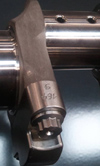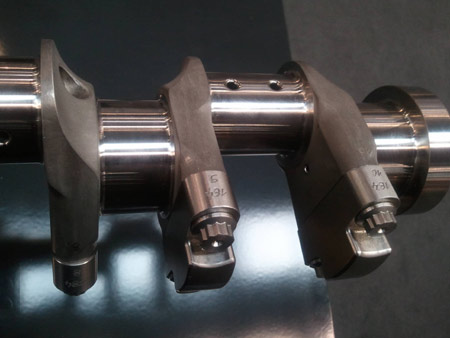Tungsten
 The use of tungsten in motor racing is widespread, especially on the chassis side of the business, where its high density makes the material prized for use as chassis ballast. Commonly cars are designed and made underweight compared to the regulations in force, and are then ballasted to meet the minimum mass. Such is the effectiveness of achieving the correct weight distribution that cars are often designed to be well underweight, and a surprisingly large proportion of their mass is carried as tungsten ballast, as close to the lowest point of the car as possible.
The use of tungsten in motor racing is widespread, especially on the chassis side of the business, where its high density makes the material prized for use as chassis ballast. Commonly cars are designed and made underweight compared to the regulations in force, and are then ballasted to meet the minimum mass. Such is the effectiveness of achieving the correct weight distribution that cars are often designed to be well underweight, and a surprisingly large proportion of their mass is carried as tungsten ballast, as close to the lowest point of the car as possible.
The use of tungsten as engine ballast where mass and centre-of-gravity regulations exist isn't out of the question, with some manufacturers again building engines very slightly underweight and ballasting them to meet the minimum weight limit. In Formula One, where the minimum height of the engine's centre of gravity is specified, the motivation for ballasting engines is minimal. In the past, it wasn't unknown to have sumps made from materials not normally associated with race engines in order to make the centre of gravity of the engine low.
However, the most common use of tungsten in the race engine is for crankshaft counterweighting, as has been discussed in a number of previous RET-Monitor articles dealing with methods of attachment. The merits of each method of attaching the tungsten to the crankshaft have been discussed, and it has been stated that the most effective method is to replace the conventional counterweight with tungsten, which is bolted to the crankshaft.
In order to prevent the crankshaft and the counterweight parting company (which is not unknown), the bolts need to be tightened to very high levels of pre-load. The bolts are often specially designed and made from special materials. The loads are such that specially processed tungsten material is required in order to prevent yielding of the tungsten under the bolt head, either during initial tightening or in service. Any yielding taking place is likely to lower the level of pre-load in the bolt and can introduce the risk of the bolt becoming loose or of joint separation. Joint separation leads to extremely high service loads in the bolt and increases the chances of the bolt failing through fatigue.

The type of tungsten alloy which is used for the highest strength of counterweight mass is processed by cold working, and commonly by swaging - a form of radial forging. This markedly increases the material's yield and tensile strength, but means that such material is generally most widely available in the form of round bars, and hence requires more machining than the lower-strength tungsten alloys which are available in the form of plates and rectangular bar. There are only a limited number of companies that can supply this material, and the most common outlet for this type of very high-strength tungsten is for military use.
There are a wide range of tungsten alloys available, and the most common alloying element is nickel, which is present in almost all the alloys that you find, with other additions of copper, iron and molybdenum. The various alloys available have a range of densities from 17g/cc to 18.5g/cc (steel is around 7.85g/cc), and it might surprise you to find that it isn't necessarily the densest alloys that are used for high-strength counterweights.
Fig. 1 - A race crankshaft with bolt-on tungsten counterweights (Courtesy of MG Sanders)
Written by Wayne Ward